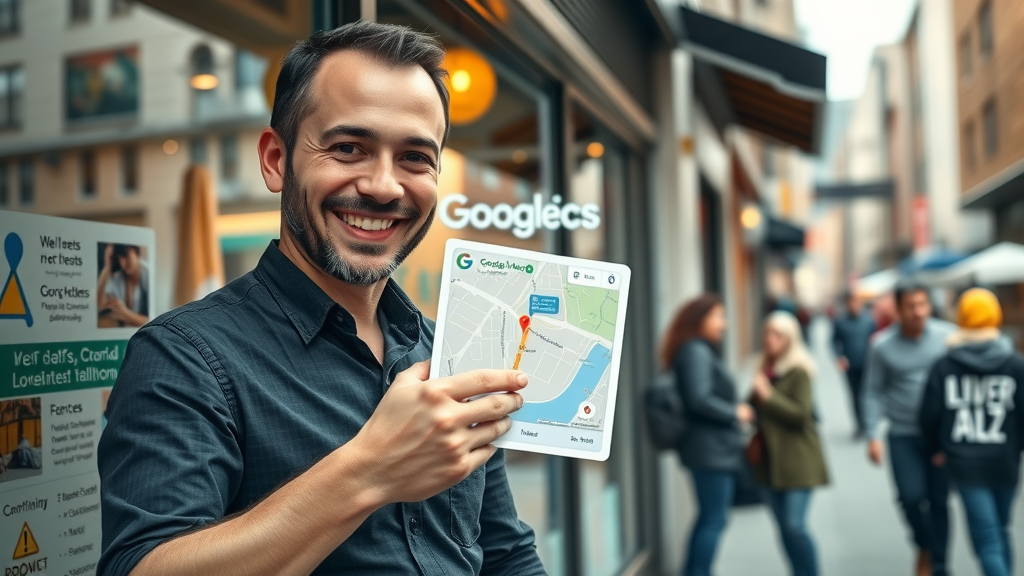If you’re a local business owner, here’s a jaw-dropping fact: nearly 46% of all Google searches are looking for local information . Imagine your business becoming the go-to spot in your area, consistently showing up in the “local pack” every time a customer is searching for what you offer. The reality? Local SEO has moved past being just a trend—it’s rapidly becoming the most essential weapon for business growth at the neighborhood level. This comprehensive guide will help you unlock local SEO’s highest potential, so you can outrank rivals and win new customers where it matters most.
Local SEO: Unlocking Your Local Business Potential with a Surprising Lead
- Did you know nearly 46% of all Google searches seek local information?
- Imagine your business appearing in the coveted local search pack, just by optimizing a few key factors.
- Local SEO isn’t just a trend—it’s your path to standing out in crowded search results.

What You’ll Gain: Master Local SEO for Ultimate Local Ranking
- In-depth understanding of local seo strategies and ranking factors
- Actionable insights for boosting your google business profile
- Comprehensive guide to achieving top placements in local search results
- Checklists and tools for ongoing local seo success
Decoding Local SEO: What Drives Local Search Rankings?
How Local SEO Impacts Local Businesses and Local Search Results
Local SEO is all about making your local business easy to discover for customers searching online in your area. By tailoring your digital presence to meet the needs of local customers, your business can easily rise above the competition in local search results. When potential clients use search engines like Google to find businesses "near me" or in their neighborhood, the businesses that have optimized for local SEO stand a far better chance of being seen—both on Google Maps and in the sought-after "local pack". This prominent visibility means increased foot traffic, more phone calls, and ultimately greater revenue for your business.
For most local businesses , appearing in top local search results is both a game-changer and an ongoing challenge. The landscape is highly competitive, but the good news is that only a small percentage of businesses fully optimize for all ranking factors, leaving tremendous room for savvy business owners to outperform their peers. By understanding the specific ranking factors that drive local search , you can tap into a steady stream of highly motivated customers who prefer to shop and spend their money locally. The potential boost for your local ranking is well worth the effort.

Understanding Search Engine Ranking Factors for Local SEO
To crack the code for better local rankings , you need to focus on factors that search engines value. Proximity —how close the searcher is to your business location—is a crucial element in local SEO . Yet, it’s just one piece. Google Business Profile optimization stands out as an essential ranking factor; ensuring your profile is up to date, complete, and rich with well-chosen photos and reviews can dramatically heighten your visibility in the local pack .
User reviews weigh heavily in local search algorithms—positive feedback signals trust and relevance, while negative reviews or lack of engagement can push your business off the radar. Additionally, consistent citations across the web, especially with uniform Name, Address, and Phone Number ( NAP ), add credibility in Google’s eyes. Businesses that master these foundational ranking factors will consistently outcompete less-optimized competitors in local search results .
- Proximity of searchers to your business
- Google business profile optimization
- User reviews as a ranking factor
- Citation and NAP consistency
Essentials for Higher Visibility: Claim Your Google Business Profile to Elevate Local SEO
Step-by-Step: Perfecting Your Google Business Setup for Search Engines
Claiming and perfecting your Google Business Profile (formerly Google My Business) is essential for dominating local search . Begin by verifying your business ownership through Google, then enter accurate and complete information, including your official business name, address, phone number, website, and relevant categories. Make sure your business info matches what’s displayed elsewhere online for maximum consistency—a key ranking factor .
Once verified, take time to optimize every section of your profile. Upload high-quality and inviting photos of your premises, services, staff, and products—businesses with compelling images see significantly higher click-through and engagement rates. Add regular posts or updates, respond to customer questions, and highlight special offers or unique selling points. A fully optimized Google Business Profile increases your odds of being featured in the local pack and at the top of search engine results for relevant queries.

Key Elements of a Winning Local Business Profile
Building a standout local business profile isn’t just about filling in the basics. Attributes like business description, category, operating hours, and especially user-submitted reviews shape your search engine visibility. Align your category tightly with your services, add detailed descriptions emphasizing local keywords, and encourage happy clients to leave reviews—this multiplies your profile’s authority and click-through rates. Below is a breakdown of the core elements you should focus on:
| Attribute | Description | Category | Hours | Reviews | Photos |
|---|---|---|---|---|---|
| Business Info | Accurate details matching all web citations | Specific to services offered | Consistent, regular updates | Encouraged & responded | High-quality, regularly updated |
Optimize Local Listings: NAP Consistency and Business Directories for Superior Local Search
Leveraging Business Directories to Strengthen Local SEO
Business directories remain a potent tool for boosting local SEO and widening your digital footprint. Listing your business on reputable directories (Yelp, Bing Places, Apple Maps, etc.) not only sends strong trust signals to search engines but also delivers direct referral traffic. Choose directories with high domain authority and relevance to your niche for the best impact on local search engine results.
The big challenge is maintenance—directories often scrape and publish outdated or mismatched details, so you must routinely check your business info for accuracy. Consistent use of your business name, phone number, and address (the NAP ) is a top local ranking factor . By ensuring your business appears authoritatively across all business directories, you help Google and other search engines trust and present your business highly in local searches.

NAP (Name, Address, Phone) Consistency as a Local Ranking Factor
NAP consistency is a non-negotiable aspect of local SEO . Search engines like Google crawl hundreds of listings, comparing your business info across directories and niche platforms. Any mismatch—like varying addresses, phone numbers, or name formats—breaks the chain of trust and can lower your local search rankings. That’s why a simple change (like moving locations or changing phone numbers) must be reflected everywhere, immediately.
- Top Business Directories to List Your Local Business
- Google Business Profile / Google Maps
- Yelp
- Bing Places
- Facebook Local
- Apple Maps
- Chamber of Commerce directories
- Industry-specific directories
- NAP Formatting Checklist
- Use consistent abbreviations (Street vs. St.)
- Double-check phone numbers for area codes
- Match business name to legal/branding docs
- Sync updates across ALL platforms instantly
Keyword Research for Local SEO: Find High-Converting Local Keywords
Uncover Local Keyword Opportunities and Integrate Them in SEO Strategy
Effective keyword research for local SEO is centered on finding search phrases that real customers in your area use before making buying decisions. Start by investing in SEO tools (like Semrush, Moz, Ahrefs, or free options like Google Keyword Planner) to reveal high-volume, low-competition local keywords. These can include service + location pairings (like “plumber in Chicago”) or local intent search terms like “near me,” “best,” or “open now.”
Once you’ve found promising local keywords , weave them naturally throughout your website copy, landing pages, blog posts, and most importantly, into your Google Business Profile . This ensures that when your target audience enters these queries in Google Search or Maps, your business is one of the top choices displayed in their search engine results.

Implementing Local Keywords in Content, Metadata, and Google Business Profile
Beyond simply identifying strong search terms during keyword research , you must implement your local keywords in strategic locations across your digital presence. Focus on your website’s meta titles, headings, URLs, and descriptions, all of which are key indicators for search engines. Your Google Business Profile should also have descriptions and posts optimized for main service and location phrases.
- Use SEO tools for local keyword research
- Best practices for long-tail and geo-specific keywords
- Common keyword mistakes to avoid
On-Page Local SEO Tactics: Optimize Every Page for Local Search
Localize Website Content: Showcase Your Local Business on Every Page
Localizing your website content is vital for standing out in local search results . Incorporate your city, neighborhood, and service area naturally throughout site content: homepages, about pages, individual service descriptions, and blog posts. Showcasing local partnerships, customer testimonials, and recognizable landmarks builds hyper-relevance for search engines and real users searching for businesses they can easily trust and visit.
Don’t overlook local images and multimedia—geotag photos and include local event calendars or service area maps. The more signals you send to Google about your local intent, the higher your chances of appearing in organic results and the coveted local pack .

Technical SEO for Local Search Engine Visibility
Technical optimization ensures that your website not only reads as local to users, but is easily understood by search engines as a trusted resource for local search . Implement schema markup for LocalBusinesses, which provides contextual business info that search engines can readily index. Optimize meta titles and descriptions with key local keywords and embed internal links to key location-based pages for deeper site authority and stronger local ranking potential.
- Schema Markup for Local Businesses
- Optimizing meta titles/descriptions with local keywords
- Internal linking to location-focused pages
Local SEO Off-Page Strategies: Backlinks, Citations, and Reviews
Building Local Backlinks to Boost Local Ranking
High-quality backlinks from locally relevant sites send powerful signals to search engines that your local business is trusted in its community. Reach out for partnerships, sponsor local events, and offer value to other nearby businesses in exchange for a spot on their website or blog. Even being listed in local news stories or city-specific resource pages can rapidly elevate your search engine credibility and move you up local rankings.
Encouraging Customer Reviews for Local SEO and Local Pack Placement
Customer reviews are a critical factor not only for user trust but also as a direct ranking signal in local SEO . Encourage satisfied customers to leave honest feedback across Google, Facebook, and other relevant review platforms. Respond to all reviews—especially negative ones—to show engagement and a positive reputation. Google values recent, authentic, and descriptive reviews, boosting your likelihood of landing in the local pack .
"Positive reviews make up nearly 15% of local ranking factors, according to recent studies."

Google Maps and Local SEO: A Guide to Dominating the Local Pack
How to Optimize Your Google Maps Listing for Top Search Results
Commanding top visibility in Google Maps (and thus the local pack ) requires completeness, regular updates, and customer engagement. Fill out all attributes, upload new photos regularly, and encourage “questions and answers” activity. Ensure your business is marked with accurate categories and a pin at the right location—accuracy is crucial for both Google and potential walk-in clients.
Remember, map results are ranked by proximity, relevance, and prominence. By consistently enriching your listing, gathering reviews, and posting relevant updates or offers, you’ll encourage Google Maps to showcase your business above organic results when local intent is clear in a search query.
| Feature | Local Pack (Google Maps) | Organic Results |
|---|---|---|
| Business Info | Profile data, NAP, directions, reviews, photos | Website meta & structured data |
| User Actions | Calls, directions, website visits, reviews | Clicks to website, view SERP snippets |
| Ranking Factors | Proximity, engagement, review score, NAP citations | Backlinks, content authority, technical SEO |
| Real-Time Updates | Posts, Q&A, special offers, operational hours | Site content refresh, update meta, blog articles |

Enhance Your Visibility in Google Map Search Results
Persistence and accuracy are your best allies. Ensure your listing is regularly updated, uniquely descriptive, and packed with current photos to reflect your true brand experience. Solicit recent reviews, answer user queries directly in Google Maps, and keep operational info fresh. Increased engagement signals not just popularity but business reliability for both Google and your neighborhood clientele.
To reinforce results, encourage customers to share their experiences with geotagged photos, leverage user-generated content on your listing, and participate in local community forums that Google Maps frequently indexes. This omnipresence ensures your business bubble remains at the top of map-based search results in your area.
Content Marketing Strategies for Local SEO Success
Local Content Ideas That Attract Customers in Your Area
Successful content marketing for local SEO means tailoring your topics and storytelling for those in your community. Create blog posts centered on local news, in-depth guides to city attractions, or round-ups of events in your area. Highlight customer stories or business partnerships—this type of hyperlocal content amplifies your site’s relevance for local search as well as building trust and engagement from actual customers living nearby.
Promoting Community Engagement for Sustainable Local SEO
Community engagement is both a signal for search engines and a tangible way to endear your brand to locals. Sponsor area meetups, support charity events, and showcase these efforts both on your site and your business profile . The more your business is woven into local happenings online and offline, the more you’ll stand out in local search results .
- Create blog posts about local events
- Feature local business partnerships
- Interview loyal local customers
Mobile Optimization: Make Your Local Business Accessible to Local Searchers
Why Mobile Experience is a Major Ranking Factor for Local SEO
With over half of all local searches happening on mobile, a lightning-fast, mobile-friendly website is no longer optional for superior local SEO . Responsive designs, click-to-call buttons, and quick page loads signal to search engines—and to real customers—that your business is easy to reach and ready to serve them in their immediate area.

Mobile Design Techniques to Improve Local Rankings
Design your site with local customers on the go in mind. Incorporate clear calls to action (like “Call Now” or “Get Directions”), simplify navigation, and use location maps on contact pages. Utilize schema for mobile search enhancements, and always preview your web pages in both iOS and Android emulators—search engines prioritize usability for mobile ‘near me’ searches.
Using SEO Tools: Boost Your Local SEO Performance
Best SEO Tools for Tracking Local Rankings and Search Results
Monitoring your local SEO progress is made effortless with the best SEO tools . Platforms like BrightLocal, Moz Local, and Whitespark are ideal for tracking local rankings , managing citations, and uncovering listing issues. Google Search Console provides invaluable local search performance data, while SEMrush and Ahrefs help you spot keyword and backlink opportunities relevant to your local market.
Leveraging Analytics to Refine Your Local SEO Strategy
Use analytics to go beyond basic traffic monitoring. Track rise and fall in local search results , citation accuracy, call or direction requests, and reviews volume. The data gathered with SEO tools uncovers what’s moving the needle for your local business so you can double down on successful tactics and adjust weak spots quickly for greater local ranking effectiveness.
| Tool | Best Features | Pricing | Best Use Cases |
|---|---|---|---|
| BrightLocal | Rank tracking, citation management, review monitoring | $39/mo+ | All-in-one local SEO tracking for agencies & small businesses |
| Moz Local | Automated listing sync, review alerts | $14/mo+ | Directory management, optimizing NAP consistency |
| Whitespark | Citation building, local rank tracking | From $17/mo | Local citation audits & individual directory listings |
| SEMrush | Keyword research, competitor analysis | $120/mo+ | Advanced research for competitive local markets |
Local SEO for Small Businesses: Tailored Tactics That Make a Difference
Local SEO Action Plan for Small Business Owners
Small businesses often have a unique advantage in local SEO : agility. Start by claiming every online business profile, especially Google Business Profile and key directories, and fix NAP across all platforms. Conduct targeted keyword research for your neighborhood or city, then pepper your website, listings, and social posts with these terms.
Build partnerships with other small businesses, join area organizations, and get featured in local guides or blogs. Solicit authentic reviews regularly, and don’t be shy about mentioning city names and local nuances in every piece of web content. Consistently monitor your local rankings and tweak your strategy monthly based on what’s working and what’s not.
Common Local SEO Challenges and How to Overcome Them
Common stumbling blocks include citation inconsistencies, lack of reviews, or even shifting local competition. Turn challenges into wins by scheduling quarterly audits with a favorite SEO tool , setting up review generation processes, and keeping up with Google Map updates. Stay focused on continuous improvement—small steps quickly add up for small business owners in the local search arena.
Voice Search and Local SEO: Preparing Your Local Business for New Search Trends
Adapting Your Business Profile for Voice-Activated Searches
As voice search on platforms like Google Assistant and Siri grows, local SEO strategies need to adapt. Optimize your business profile with conversational, question-based language (“Where is the closest coffee shop?” “Who offers emergency plumbing in Austin?”) and ensure your NAP info is precise and up-to-date for easy retrieval via voice commands.
Crafting Conversational Content to Capture Voice Search Traffic
On your website, add FAQ pages and service descriptions that mirror how real people speak (“What’s the best time to visit our bakery?”). Use long-tail phrases, user questions, and clear answers. The more your content mimics natural speech, the more you capture high-value voice and mobile search traffic in your local market.
Track, Measure, and Adjust: Ongoing Local SEO Optimization
Key Local SEO Metrics to Monitor Regularly
Professional local SEO is never “set and forget.” Regularly monitor metrics like local pack ranking shifts, organic results click-through rates, volume of customer reviews, and Google Business Profile engagement. Watch traffic sources—see how many users found you from local search queries versus directory listings. This constant measurement is where smart adjustments are born.
How to Adjust Strategies for Continuous Local Ranking Growth
Review your metrics, identify weak points, and implement A/B testing for fresh ideas. Update your content monthly, keep NAP and business info current, and seek new backlinks or reviews. By measuring consistently and taking small, focused actions, you ensure your local rankings not only improve, but stay high above the competition.
- Track local pack ranking changes
- Monitor business info consistency
- Review traffic from local search queries
Expert Insight: Winning Quotes from Leading Local SEO Authorities
"Local SEO is the single most effective strategy for businesses wanting to own their local market—don’t ignore its power." – Local SEO Expert
"Consistency and credibility are the backbone of local search success." – Digital Marketing Leader
People Also Ask: Answering Top Local SEO Questions
Is doing a local SEO worth it?
Absolutely. Local SEO increases your business visibility, drives targeted foot traffic and online calls, and often produces higher ROI than traditional advertising for local businesses. It’s a foundational investment for companies relying on local searchers.
Is local SEO free?
While you can improve local SEO with free strategies like optimizing your Google Business Profile and earning reviews, achieving competitive results often requires investment in tools, professional help, or premium listing services.
Can I do local SEO myself?
Yes, many local SEO tasks—like claiming your Google Business Profile, local keyword research, and managing reviews—can be DIY. However, mastering advanced strategies or competing in saturated local markets may warrant expert help.
How much does a local SEO cost?
Costs for local SEO range from free basics to several hundred or even thousands per month for managed services, depending on competition, business size, and goals. Typical small business budgets are $500–$2,500/month.
Frequently Asked Questions About Local SEO
- How long does it take to see local SEO results?
- Do reviews really impact local ranking?
- What’s the difference between local SEO and organic SEO?
- Should my business have separate pages for each location?
Key Strategies to Remember for Local SEO Excellence
- Keep your business info up to date everywhere
- Encourage authentic customer reviews
- Prioritize Google Business Profile optimization
- Invest in mobile-first design and local content
Take the First Step: Transform Your Local SEO and Outrank Rivals Today
- Audit your local SEO readiness using this checklist
- Update your Google Business Profile now
- Start tracking your local rankings with recommended SEO tools
- Take action today to secure your top spot in local search results
Start optimizing for local SEO now —and watch your business stand out in your neighborhood’s search results!
 Add Row
Add Row  Add
Add 




Write A Comment